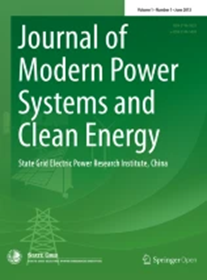Two-stage Transient-Stability-Constrained Optimal Power Flow for Preventive Control of Rotor Angle Stability and Voltage Sags
IF 5.7
1区 工程技术
Q1 ENGINEERING, ELECTRICAL & ELECTRONIC
Journal of Modern Power Systems and Clean Energy
Pub Date : 2023-12-28
DOI:10.35833/MPCE.2023.000461
引用次数: 0
Abstract
In practice, an equilibrium point of the power system is considered transiently secure if it can withstand a specified contingency by maintaining transient evolution of rotor angles and voltage magnitudes within set bounds. A novel sequential approach is proposed to obtain transiently stable equilibrium points through the preventive control of transient stability and transient voltage sag (TVS) problems caused by a severe disturbance. The proposed approach conducts a sequence of non-heuristic optimal active power re-dispatch of the generators to steer the system toward a transiently secure operating point by sequentially solving the transient-stability-constrained optimal power flow (TSC-OPF) problems. In the proposed approach, there are two sequential projection stages, with the first stage ensuring the rotor angle stability and the second stage removing TVS in voltage magnitudes. In both projection stages, the projection operation corresponds to the TSC-OPF, with its formulation directly derived by adding only two steady-state variable-based transient constraints to the conventional OPF problem. The effectiveness of this approach is numerically demonstrated in terms of its accuracy and computational performance by using the Western System Coordinated Council (WSCC) 3-machine 9-bus system and an equivalent model of the Mexican 46-machine 190-bus system.预防性控制转子角度稳定性和电压骤降的两阶段暂态稳定性约束优化功率流
在实践中,如果电力系统的平衡点能通过将转子角度和电压幅值的暂态变化保持在设定的范围内来承受特定的突发事件,则该平衡点被认为是暂态安全的。本文提出了一种新颖的顺序方法,通过对严重扰动引起的暂态稳定和暂态电压下陷 (TVS) 问题进行预防性控制,从而获得暂态稳定的平衡点。该方法通过顺序求解暂态稳定约束的最优功率流(TSC-OPF)问题,对发电机进行一连串非启发式最优有功功率再分配,以引导系统达到暂态安全运行点。在所提出的方法中,有两个顺序投影阶段,第一阶段确保转子角度稳定,第二阶段消除电压幅值中的 TVS。在这两个投影阶段中,投影操作都与 TSC-OPF 相对应,其表述方式是在传统 OPF 问题中仅添加两个基于稳态变量的瞬态约束,从而直接得出。通过使用西部系统协调委员会 (WSCC) 的 3 台机器 9 总线系统和墨西哥 46 台机器 190 总线系统的等效模型,从精度和计算性能方面对该方法的有效性进行了数值验证。
本文章由计算机程序翻译,如有差异,请以英文原文为准。
求助全文
约1分钟内获得全文
求助全文
来源期刊

Journal of Modern Power Systems and Clean Energy
ENGINEERING, ELECTRICAL & ELECTRONIC-
CiteScore
12.30
自引率
14.30%
发文量
97
审稿时长
13 weeks
期刊介绍:
Journal of Modern Power Systems and Clean Energy (MPCE), commencing from June, 2013, is a newly established, peer-reviewed and quarterly published journal in English. It is the first international power engineering journal originated in mainland China. MPCE publishes original papers, short letters and review articles in the field of modern power systems with focus on smart grid technology and renewable energy integration, etc.
 求助内容:
求助内容: 应助结果提醒方式:
应助结果提醒方式:


